Archive for Tips & Ideas
January 17, 2006 at 1:17 pm · Filed under Tips & Ideas
Frequently in online RV travel forums, someone writes to ask, “What tools should I bring with me on trips for emergency repairs?” This inevitably results in a firestorm of lists from every anal-compulsive male member of the forum, each list being bigger and better than all its predecessors, trumping and trumping again until the final toolkit is so large that it would require a trailer all its own.
I tend to take a more minimalist approach. I’ll fix the basic stuff, and leave the big problems to trained professionals. (For this reason, the more important tool in my kit is the gold credit card in my wallet.) You know the basic tools we carry (duct tape, screwdrivers, rivet gun, etc), but there are a few specialized items that you’d never think of until the day you need them.
For example, we encountered our first road-borne rock in Oregon. The darned thing hit the front of the trailer like it was fired from a sniper rifle, and left a nice round half-inch ding in the driver’s side curved section of the trailer ““ right above the stoneguards, of course.
For this sort of metal repair, you have two choices: (1) have it repaired at enormous expense; (2) cover it up. I chose option 2, using my favorite Airstream beauty secret: the fake bullet hole.
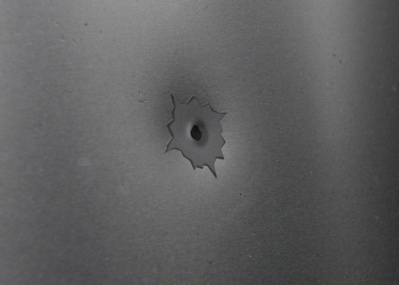
Available from ” Hardley Dangerous Illusions”, the fake bullet hole comes in a variety of sizes to accommodate just about any annoying ding in seconds. Best of all, with a slight indent on the trailer, the bullet hole looks remarkably realistic and provides a great conversation starter at rallies and campgrounds. I prefer the .38 calibre for general repairs.
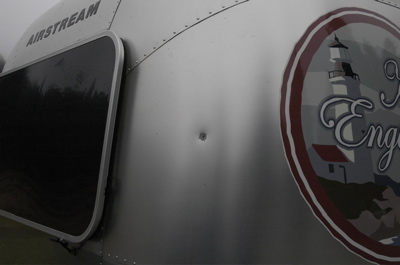
Quick and easy aluminum “repair” for $1!
January 8, 2006 at 7:09 am · Filed under Tips & Ideas
The longer we stay in Borrego Springs, the more we discover. The history and geography of Anza-Borrego is so extensive that it has spawned several thick books. And the “hidden” parts of the park are just enormous.
We took a hike yesterday morning to spot some bighorn sheep. Four trips to Anza-Borrego and I’ve never seen one, although they are very common in the hills here. After a mile of hiking we saw a ram and a ewe leaping from rock to rock at an unbelievable speed. It was all I could do to get my camera pointed and firing before they disappeared. Even at three shots per second, I only managed to get a few images.
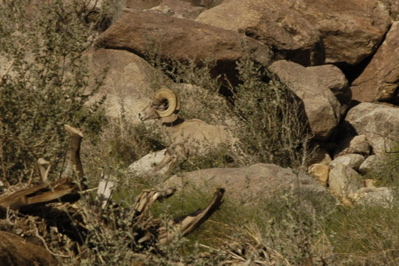
You can see how well camouflaged these animals are. If it weren’t for their rapid movement, we probably wouldn’t have spotted them at all. Although we stayed out for another hour on the trail, we didn’t spot any others. This pair managed to double back and sneak past us (by climbing high into the hills) later. I am amazed the mountain lions ever manage to catch one.
Saturday I also dropped in on an ranger talk about the Carrizo Gorge Railroad, which passes through this park to the south. Eleanor and I had hiked about six miles of the inactive railroad bed back in the mid-90s (where we had a surprising encounter with a group of nudists, but that’s another story). I wanted to find out why the railroad was ever built, since it was an impossibly twisty route with over fifteen tunnels and enormous bridges made of 8×10 redwood posts.
Turns out the railroad was an unprofitable disaster since it opened in 1919. Floods, derailments, tunnel collapses, Mexican bandits, and many other problems occurred over the decades. It was finally abandoned in 1983, but in 2003 the County of San Diego announced plans to bring it back. Now it is being policed and we can’t hike it anymore, which is a shame since it is an amazingly scenic trail.
Last night we went to a campfire talk with another ranger. The subject was the Fish Creek parcel of the park, where we went offroading on Friday. The talk really rounded out our experience. Whenever we are in national parks, we aim for the ranger talks because they give you an appreciation and understanding of the place that you can’t get by just wandering around with a trail map.
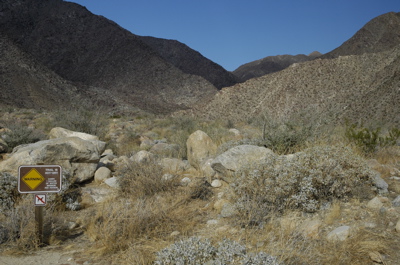
Our Saturday morning hike. Trailhead sign says, “Trail is HOT – DRY. Bring one gallon of water per person.”
December 26, 2005 at 6:26 pm · Filed under Tips & Ideas
I went to bed last night knowing I was getting a cold — again — and today when I woke up, there it was, in my head, telling me I wasn’t going to the museums or the Old Town or the state Historic Park today.
But that’s OK. We all needed a quiet day. E & E parked themselves at the dinette and worked on their various projects (drawing for Emma, and writing a Christmas letter for Eleanor), while I cleaned up old email correspondence using my laptop in bed.
At 1:30 pm we had to move the Airstream to another site. When we arrived at Sweetwater Summit, our site couldn’t be booked for the whole week. We knew that on Monday we’d have to hitch up and go 100 feet to a different one. Not a problem either, since it was time to dump the tanks. By 2:30 we were done and set up in the new site, and the sun was shining, my head was feeling better, and it was time to launch Operation Kill Paper.
We headed out to Circuit City and bought a Canoscan LiDE 60, which is a $80 scanner. It’s slim and lightweight, perfect for RV life. With it, I plan to eliminate all the folders of paper which currently occupy two large file boxes in the back of the truck.
If you only use your Airstream for recreation, you don’t have this problem. But I have to travel with an entire office all the time. It’s amazing that I can operate a magazine with only two boxes of paper (everything else is digital), but I’m not satisfied yet. Those last two boxes have been a persistent thorn in our sides. They don’t fit in the trailer well. They take up too much space in the truck. And 99% of the time, we don’t need them. It’s just stuff we are carting around “just in case”, like receipts, paid invoices, tax records, documentation, etc.
Well, my photos are digital. My writing is digital. My music is digital. And it all fits on a backup hard drive only about 6 inches long by 3.5 inches wide. So why am I carting around two big boxes just for a some paper documents I hardly ever need?
Let Operation “Kill Paper” begin! I just put the paper into the scanner, press one button, and it turns into electrons in about 10 seconds. Then the paper goes in the shredder. Ahh, the joy of eliminating unneeded stuff!
This week, while I am sick with a cold and have not a lot of other work to do, I am going to scan as much old paper into PDF format as I can. Not only will it save a ton of valuable space (and full-timing with a family, every cubic inch counts), but the resulting files are searchable, so I can find documents much more quickly than I could before. I’ll let you know how it goes.
Tonight Eleanor is making the pork roast. I can smell it even with a stuffy nose and it smells wonderful. Hopefully tomorrow I’ll be feeling better and we’ll go out. But if not, I’m going to send E & E out and I’ll stay here and scan to my heart’s content.
December 23, 2005 at 7:40 am · Filed under Tips & Ideas
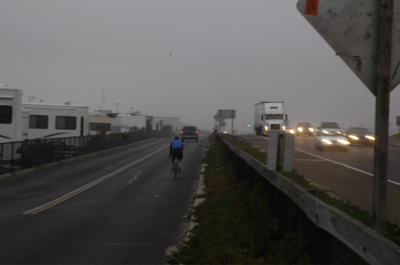
Here’s a picture taken this morning … fog today, but the weather report says it will clear up soon. Still, you can see how little space there is between the RVs and the Pacific Coast Highway.
For the past week I have been noticing that we need to get a wash. (Not us, the truck and trailer!) After a couple of weeks of traveling by highway, and near the coast, the entire rig gets coated with a brownish oily film. It doesn’t look dirty, but the sticky mixture comes off on our clothes, hands, and makes the Airstream looks less shiny. Can’t have that! 😉
We can wash the truck by unhitching and removing the bikes from the roof — then it fits in most car washes — but the trailer is a another story. We had a few “interesting” experiences trying to fit it into manual car washes. They don’t usually have enough entry/departure area for a 30-foot trailer.
Washing by hand would be an option except that all campgrounds prohibit this. I was hoping we’d end up at someone’s house (courtesy parking) and they’d let me wash it, but this hasn’t happened since we visited Lou & Larry in Ohio.
So a truck wash is the most practical option. Blue Beacon runs a chain of them across the country, co-located with truck stops such as Petro and Flying J. There are usually local truck washes in major cities as well. It’s expensive (about $40) but worth it. They do a nice job and everything gets clean, including the bikes. A whole crew of guys comes out with high-pressure wands, spray everything about six times, and voila! shiny again.
Our last wash was in Nevada, a couple hundred miles after we boondocked in central Nevada (see November archives for details). We’re due. I did a little research online last night and found a truck wash that is approximately along our route out today, so we’ll try to stop there this morning.
December 22, 2005 at 7:33 pm · Filed under Tips & Ideas
Our Wal-Mart experience was a bust last night. At 10:30, we were surprised to hear a knock on our door. The manager of the store was there, apologetically explaining that although he had no problem with us parking, the Torrance police were known for placing “very expensive” tickets on RVs parked in the lot. The security guard who had told us it was OK was not aware of this. So, off we went — driving in pajamas — in search of a new spot to park. (The Bolsa Chica State Beach campground in Huntington Beach, our original destination, was not an option. The gates are locked at 9 pm.)
The good news is that the L.A. area is loaded with neighborhoods and industrial areas where one can park overnight, if you are subtle. The bad news is that our trailer, 30 feet of gleaming aluminum festooned with giant colorful graphics, is not subtle. So Eleanor punched “Camping World” into the GPS and it turned out there was one just a few miles away on I-5. By 11, we were tucked away behind a few big motorhomes in the Camping World parking lot, and back in bed.
We’ve stayed at Wal-Marts and other such places many times, but never have we been “moved on” by The Man. Still, we always knew it was a risk. We have enough experience finding places to park that there was never any doubt we’d find a good spot. There are no commercial campgrounds to be had in most of the L.A. area, but we have a long list of free places to try:
Wal-Mart
Super K-Mart
Cracker Barrel
Camping World
truck stops
certain fast food restaurants
municipal and county parks & parking lots
neighborhoods where RVs are visible on the street
harbor and industrial areas
unnamed pullouts
The first thing to do when checking out a spot is to look for a sign that says “Overnight parking prohibited” or words to that effect. The second thing to do is to ask anyone in authority (parking lot owner, local police, security guard) if they mind if you park there “for a few hours”. The third thing to do is to make sure you feel comfortable with the spot, and finally the fourth thing to do is to park subtly (no satellite dish, no awning, no slideouts, etc) and leave early. With this strategy we have successfully parked for free many times in at least a dozen different US states.
We are going to have a bunch of articles on this subject in the next Airstream Life magazine (coming out in January). We’ve got a piece on boondocking, another on how Wally Byam selected free parking spots in the 1950s, and a third piece on selecting a generator to use when you are parked far away from town.
« Previous entries






